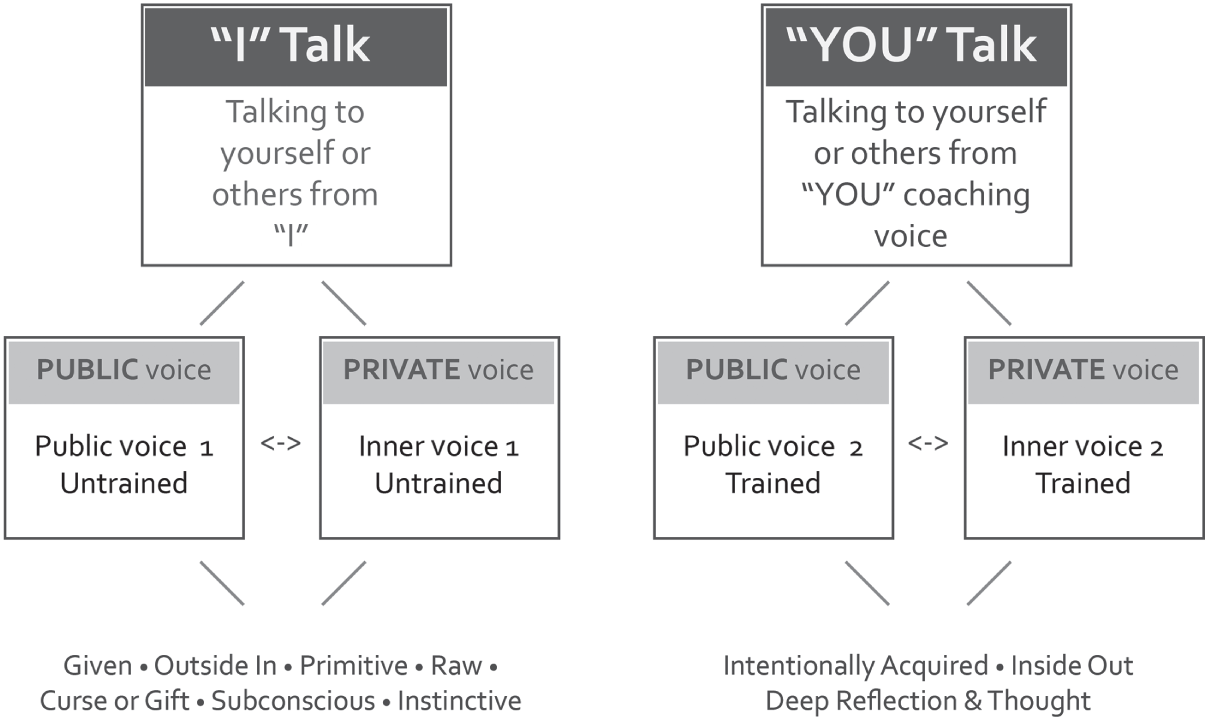Chapter 3
The Voices in Our Head
When you speak from that deep, inner voice, you are really speaking from the unique tabernacle of your own presence. There is a voice within you that no one, not even you, has ever heard. Give yourself the opportunity of silence and begin to develop your listening in order to hear, deep within yourself, the music of your own spirit.
—Anam Cara, by John O’Donohue
There are some crucial points to understand. First, “voices in our head” are completely normal. We all have them. Second, getting through to your inner core, your central command center, means getting through to your inner voice, which represents the power broker in decision‐making. Inner speech is the brain's way of talking to itself. One's inner voice, which only that person can hear, is the brain's gatekeeper, chief storyteller, and, most importantly, master decision maker. One's inner voice is direct talk from the brain's command center. Man's remarkable capacity for complex language has equipped the brain with the ability to speak to itself through words.
The younger the brain, the more sensitive and malleable to inputs from the outside world. The child's brain is a super‐charged learning machine. Inputs to the infant brain come primarily from visual, auditory, and kinesthetic stimuli. Evidence suggests that auditory inputs and biological messages are transmitted even prenatally from the voices of parents, grandparents, siblings, and others, but most particularly the mother.
Termed “maternal‐fetal synchrony,” the mother and unborn child communicate in profoundly impactful ways throughout pregnancy, both verbally and nonverbally. The fetus absorbs all, and in addition to hearing their mother's voice and tone, any stress or discomfort that activates maternal cortisol passes through to the fetus as well, via cortisol receptors on the placenta. When the mother's heart rate or blood pressure go up, the fetus responds accordingly.
These inputs (multilevel messages) are stored in the more primitive areas of the fetal brain (brainstem and limbic system) because the higher‐order brain (cortex and neocortex) is not yet adequately developed to have capacity to make sense of these messages. Importantly, maturation and integration of these higher‐order brain structures is a process that unfolds through an individual's late 20s and early 30s.
As the child's capacity for language develops, the totality of sensory inputs eventually takes the form of a crude internal private narrative. This represents the beginning of one's inner voice, something we'll call Inner Voice 1. The message and the tone of this developing voice is a direct reflection of the accumulated neurological inputs from parents, teachers, siblings, and so on. Inner Voice 1 is formed and operates for the most part unconsciously. It flows directly from one's central command center. Characteristics of Inner Voice 1 include the following:
|
|
One's inner voice can be a significant detriment in life, or it can be a life‐enhancing asset in our effort to make sound and responsible choices. It can, unfortunately, be overly self‐critical, condescending, derogatory, caustic, immature, or narcissistic, anything but a wise advisor. It can also be supportive, encouraging, kind, insightful, patient, and wise. A dysfunctional voice breeds chaos and bad choices, and a healthy, constructive one breeds order and better choices.
It's important to understand that untrained Inner Voice 1 may or may not reflect the world as it actually exists. Distortions in what we see and the stories we tell ourselves are common. When the stories crafted by Inner Voice 1 are faulty or ill‐conceived, the advice or decisions that emanate from those faulty interpretations will likely be flawed as well.
From Inner Voice 1 to Inner Voice 2
Inner Voice 2 is the deliberate transformation of Inner Voice 1 into the voice of a great coach: reliable, mature, wise, and reasonable. Inner Voice 2 is intentionally acquired and consciously trained. Inner Voice 2 makes Inner Voice 1 conscious and unearths deficiencies and shortcomings in tone and message. Inner Voice 2 can stop Inner Voice 1 instantly from going rogue. Inner Voice 2 is pre‐coded with critical life navigational instructions (coordinates) that include:
|
|
Inner Voice 2 is made possible from the evolutionary upgrade of conscious awareness. Humans are capable of being fully aware of the tone and content of their private, inner voice. The goal is to transform Inner Voice 1 into a masterful, reality‐based resource filled with wisdom and great counsel that can be accessed throughout one's life.
Properly trained, Inner Voice 2 becomes a repository of wisdom, sound judgment, and perspective. It becomes the voice of a valued and trusted personal coach, one's own brilliant Y.O.D.A.
“You Talk” and “I Talk”
The brain can coach and advise itself in the same way a coach talks, in the second person. We'll call it “You Talk”: “You need to work harder.” “You need to be more positive with yourself.” “You have much more ability than you think.”
Word messages in the first person we'll call “I Talk”: “I should not be late.” “I need to try harder.” “I can do this.” Both “You Talk” and “I Talk” can be helpful or destructive, wise or foolish. Both “You Talk” and “I Talk” can also be made public or kept entirely private. (See Figure 3.1.)
Just as we all have an acquired, untrained inner voice, we also have an acquired, untrained public voice; we'll call it Public Voice 1. Public Voice 1 is the brain speaking to itself publicly and, because it is raw, uncensored, and untrained, the tone and message may be shocking and completely inappropriate.
Trained public “You Talk,” referred to as Public Voice 2, is “you” coaching “you,” out loud with great wisdom and perspective. “You need to do this.” “You cannot give up.” You're saying such things out loud to yourself in your best trained public voice.

Figure 3.1 The voices in our head.

Figure 3.2 Transformation of Y.O.D.A.
An important focus of this book will be transforming Inner Voice 1 into Inner Voice 2: a wise and trusted advisor in making crucial decisions throughout your lifetime. The goal is to develop your own trained, brilliant resident advisor. (See Figure 3.2.)
Sources
- Carruthers, P. “The Cognitive Functions of Language.” Behavioral and Brain Sciences 25 (2002): 657–726.
- Kross, E. Chatter, The Voice in Our Head, Why It Matters, and How to Harness It. New York: Random House, 2021.
- Emerson, M. J., and A. Miyake. “The Role of Inner Speech in Task Switching: A Dual‐Task Investigation.” Journal of Memory and Language 48 (2003): 148–168.
- Fernyhough, C. The Voices Within: The History and Science of How We Talk to Ourselves. New York: Basic Books, 2016.
- Finn, J. A. “Competitive Excellence: It's a Matter of Mind and Body.” Physician and Sportsmedicine 13 (1985): 61–75.
- Gathercole, S. E., and A. D. Baddeley. Working Memory and Language. Hove, UK: Erlbaum, 1993.
- Gentner, D., and S. Goldin‐Meadow (Eds.). Language in Mind: Advances in the Study of Language and Thought. Cambridge, MA: MIT Press, 2003.
- Gould, D., R. C. Eklund, and S. A. Jackson. “1988 U.S. Olympic Wrestling Excellence: II. Thoughts and Affect Occurring During Competition.” Sport Psychologist 6 (1992): 383–402.
- Gruber, O., and T. Goschke. “Executive Control Emerging from Dynamic Interactions between Brain Systems Mediating Language, Working Memory and Attentional Processes.” Acta Psychologica 115 (2004): 105–121.
- Hardy, J. “Speaking Clearly: A Critical Review of the Self‐Talk Literature.” Psychology of Sport & Exercise 7 (2006): 81–97.
- Hardy, J., K. Gammage, and C. R. Hall. “A Descriptive Study of an Athlete's Self‐Talk.” Sport Psychologist 15 (2011): 306–318.
- Hardy, J., C. R. Hall, and L. Hardy. “Quantifying Self‐Talk.” Journal of Sports Sciences 23 (2005): 905–917.
- Harvey, D. T., J. L. Van Raalte, and B. W. Brewer. “Relationship between Self‐Talk and Golf Performance.” International Sports Journal 6 (2002): 84–91.
- Hatzigeorgiadis, A. “Instructional and Motivational Self‐Talk: An Investigation on Perceived Self‐Talk Functions.” Hellenic Journal of Psychology 3 (2006): 164–175.
- Hatzigeorgiadis, A., Y. Theodorkis, and N. Zourbanos. “Self‐Talk in the Swimming Pool: The Effects of Self‐Talk on Thought Content and Performance on Water‐Polo Tasks.” Journal of Applied Sport Psychology I6 (2004): 138–150.
- Hatzigeorgiadis, A., N. Zourbanos, and Y. Theodorakis. “An Examination on the Moderating Effects of Self‐Talk Content on Self‐Talk Functions.” Journal of Applied Sport Psychology 19 (2007): 241–250.
- Johnson, J. J. M., D. W. Hrycaiko, G. V. Johnson, and J. M. Hallas. “Self‐Talk and Female Youth Soccer Performance.” Sport Psychologist 18 (2004): 44–59.
- Landin, D., and E. P. Hebert. “The Influence of Self‐Talk on the Performance of Skilled Female Tennis Players.” Journal of Applied Sport Psychology 11 (1999): 263–282.
- Lazarus, R. S. “Thoughts on the Relation Between Emotion and Cognition.” American Psychologist 37 (1982): 1019–1024.
- Luria, A. R. The Role of Speech in the Regulation of Normal and Abnormal Behavior. New York: Liveright, 1961.
- Perkos, S., Y. Theodorakis, and S. Chroni. “Enhancing Performance and Skill Acquisition in Novice Basketball Players with Instructional Self‐Talk.” Sport Psychologist 16 (2002): 368–383.
- Peters, H. J., and J. M. Williams. What Type of Self‐Talk Do Athletes Believe Help and Hurt Their Performance? Poster Presented at the Meeting of the Association for the Advancement of Applied Sport Psychology, Philadelphia, 2003.
- Ramirez, J. D. “The Functional Differentiation of Social and Private Speech: A Dialogic Approach.” In R. M. Diaz and L. E. Berk (Eds.), Private Speech: From Social Interaction to Self‐Regulation. Hillsdale, NJ: Erlbaum, 1992.
- Rushall, B. S., M. Hall, L. Roux, J. Sasseville, and A. C. Rushall. “Effects of Three Types of Thought Content Instructions on Skiing Performance.” Sport Psychologist 2 (1988): 283–297.
- Theodorakis, Y., S. Chroni, K. Laparidis, V. Bebestos, and I. Douma. “Self‐Talk in a Basketball‐Shooting Task.” Perceptual and Motor Skills 92 (2001): 309–315.
- Theodorakis, Y., R. Weinberg, P. Natsis, I. Douma, and P. Kazakas. “The Effects of Motivational and Instructional Self‐Talk on Improving Motor Performance.” Sport Psychologist 14 (2000): 253–271.
- Van Noorde, N. L. Development and Evaluation of a Self‐Talk Assessment Instrument for Tennis Players. Unpublished doctoral dissertation, Michigan State University, East Lansing, MI, 1984.
- Van Raalte, J. L., B. W. Brewer, B. P. Lewis, D. E. Linder, G. Wildman, and J. Kozimor. “Cork! The Effects of Positive and Negative Self‐Talk on Dart Performance.” Journal of Sport Behavior 3 (1995): 50–57.
- Van Raalte, J. L., B. W. Brewer, P. M. Rivera, and A. J. Petitpas. “The Relationship between Observable Self‐Talk and Competitive Junior Players’ Match Performances.” Journal of Sport and Exercise Psychology 16 (1994): 400–415.
- Van Raalte, J. L., A. E. Cornelius, B. W. Brewer, and S. J. Hatton. “The Antecedents and Consequences of Self‐Talk in Competitive Tennis.” Journal of Sport and Exercise Psychology 22 (2000): 345–356.
- Vygotsky, L. Thought and Language (A. Kozulin, Trans.). Cambridge, MA: MIT Press, 1986 (Original work published in 1934).
- Vygotsky, L. Thinking and Speech: The Collected Works of Lev Vygotsky, vol. 1. New York: Plenum Press, 1987.
- Weinberg, R. S., J. Smith, A. Jackson, and D. Gould. “Effect of Association, Dissociation, and Positive Self‐Talk on Endurance Performance.” Canadian Journal of Applied Sport Sciences 9 (1984): 25–32.
